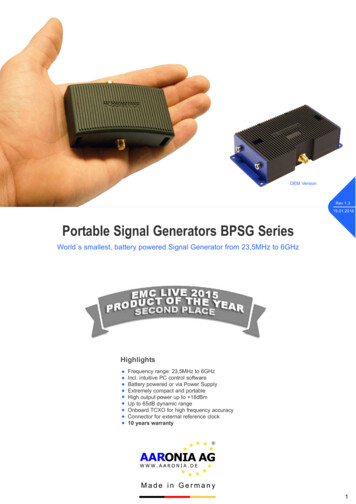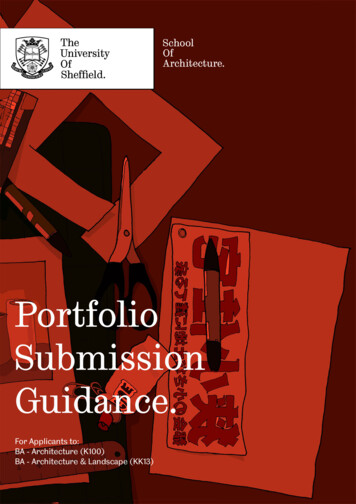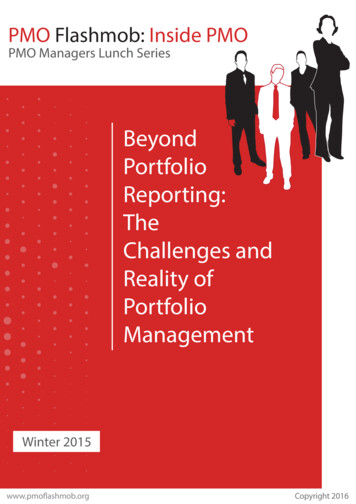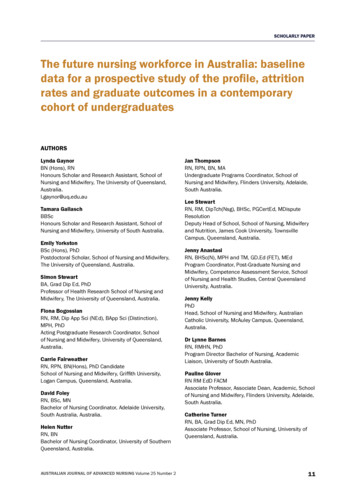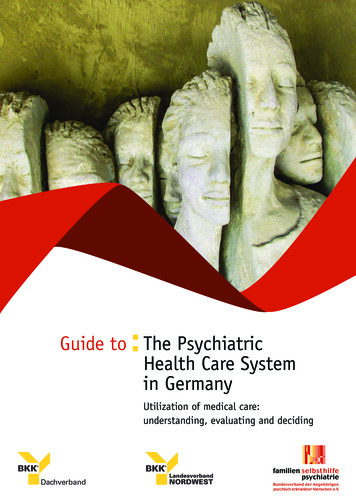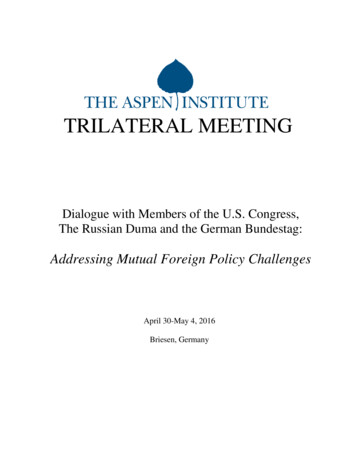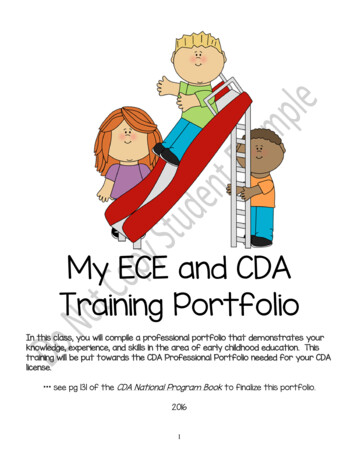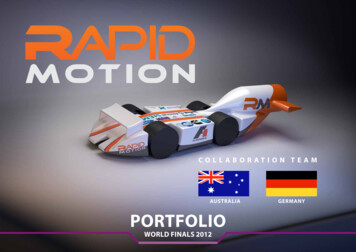
Transcription
C oll a b or a tio n T e a maustraliaPORTFOLIOWorld Finals 2012germany
About Us / The TeamTeam NameTo symbolise the collaborative natureof our team, the name ‘Rapid Motion’is derived from a combination of ournational team names. Originally knownas ‘Rapid Racing’ from Australia and‘Motion Blur’ from Germany.Team GoalPut simply and ambitiously, our goal isto be the first collaboration team towin the World Finals in Abu Dhabi.Team MottoOur motto - “Unleash Potential”was chosen because we believe thatwith collaboration and commitment,innovation and imagination, and apositive attitude, team ‘Rapid Motion’will unleash its potential energy onthe world stage.Meet the TeamActive team membersSupport team membersEvan PignatelliTeam Manager / Design EngineerFriedrich von BülowResource Manager / Graphics DesignerEvan monitored team progress to ensureeveryone completed tasks. He workedclosely with Lukas in Germany and betweenthem, they organised team meetings tocommunicate, discuss issues and plantasks. Evan also designed the final team caron CATIA and used virtual wind tunnelprograms to analyse car designs.Friedrich was responsible for finance, and theservice and production sponsors in Germany.He ensured that team commitments tothese sponsors were followed. Friedrich alsoliaised with support team members aboutgraphic design matters.Sam ManningResource Manager / Graphics DesignerSebastian WittDesign EngineerSam monitored team expenditure inAustralia, contacted sponsors and helped toorganise fund raising events. He also liaisedwith Robin to develop the team’s touchscreen for the pit display and the design ofthe team shirts.Sebastian designed the car’s wheel systemon Solid Edge. He also created an innovativeconcept car, which requires furtherrefinement but has great promise. He andEvan liaised closely on design concepts,especially when he visited Australia. He alsocreated the final render for the car and theteam promotional video.Robin RömerResource ManagerRobin supported the team regardingsponsorship and public relations in Germany.He organised meetings with sponsors andthe media and ensured that commitmentsto sponsors were enforced. Robin providedadditional support, as it was required.Tom HardyManufacturing EngineerTom was in charge of machining and testinghigh quality cars on the CNC DenfordRouter. He also prepared and painted the testcars and produced the team’s orthographicdrawings.2Blake GilliganResearch ManagerFelix SchmidtGraphics and Web Page DesignerHendrik PommereningGraphics DesignerLukas GüldensteinGerman Team ManagerJack FoyleTeam Support
Team History / Team CollaborationRapid RacingTeam ‘Rapid Racing’ are from Engadine HighSchool in NSW, Australia. Team members,Evan, Sam, Tom, Blake and Jack are the 2012National champions in the DevelopmentClass in the ‘F1inSchools’ TechnologyChallenge. They also won national awardsfor Industry Collaboration, Innovation andMarketing.16.300km8 hoursMotion BlurTeam‘MotionBlur’arefromSachsenwaldschule Gymnasium SchoolReinbek in Hamburg, Germany. Teammembers, Lukas, Robin, Sebastian, Friedrich,Felix and Hendrik are the National ViceChampions and winners of the ConstructionAward.Collaboration – howunited across the globeweIn any group or business, teamwork is animportant part of getting the job done.Teams who enter the ‘F1 in Schools CarChallenge’ confront many challenges in theirquest to win the prestigious world title. Asa collaborating team, these challenges are allthe greater.The pressure of communicating acrossdifferent time zones, discussing innovativeideas, and adhering to timeframes was difficultbut we made it possible. We used a fourhour potential time period, most Mondays,to communicate during the late afternoon/evening in Australia, while German studentswere still in school, to set tasks for the weekahead.To achieve our goals, we structured ourteam so that everyone had clear rolesand understood the importance of theircontribution to the team.To further enhanceteamwork, team members from Germanyand Australia were paired so they couldcollaborate on areas of similar interest andshare ideas. As team managers, Evan andused email, Facebook andWebex to plan and monitorprogress and the completion of3LukasCiscoteamtasks. Sebastian stayed with Evan in Australia,which enabled them to discuss designconcepts, machine initial test cars atEngadine High School and share ideasabout potential wheel designs. This visitbreached the distance between the twoteams and developed genuine friendships. A very talented group of GraphicDesigners,Friedrich,Hendrik,Felix and Samcollaborated with each other to proposedifferent designs for Rapid Motion’s pitdisplay, touch screen display, team logo,team website, apparel and portfolio. Resource Managers, Friedrich, Robin,Sam and Blake worked together topropose different marketing strategiesto encourage sponsorship interest inthe team and ensure that sponsors werepromoted to the wider community andon the world stage.
Team IdentityCorporate IdentityAttention to detail is evident in the way inwhich we established our corporate identityfrom the start. Our team web page, www.teamrapidmotion.com, clearly specifiesteam colours and acceptable fonts and logosto be used on light or dark backgrounds.This screen shot is an example of the teamcolours that are consistently promotedthrough the pit display, portfolio, teamuniforms, marketing and the team car. to remember our name. Our logo highlightsour name Rapid Motion, and is also availableas an acronym. The bright orange ‘R’ and thedark grey ‘M’ represent our primary teamcolours.The logo was designed to look sleekand represent a racetrack, as shown by thecurved letters.Team Car IdentityCompetition shirts are split into twocategories – ‘Active’ and ‘Support’.As a team,we wanted all team members from bothcountries to be recognised as members ofRapid Motion, so our shirt designs are similarbut different. Members of the team whocompete in Abu Dhabi will wear the ‘Active’design; and team members who providesupport will wear the ‘Support’ design.Consistent with other applications of ourcorporate identity,our final car render closelyreflects team colours - predominantly whiteand orange with a hint of grey and purple.Decal stencils were used for graphics.Team UniformsTeam LogoTeam pants are black and these were donatedto us from ‘5.11 Tactical Series’ clothing.Theyare high quality pants and are worn by largepolice networks around the world such asthe FBI, New York, L.A and Australian Police.Competition Uniform Our logo is simple yet distinctive and effectiveto encourage spectators and competitorsOur competition uniforms were designedaround three main factors – eye-catching,comfort, and climate. The shirts are made ofpolyester, which provides maximum comfortand no itch. The design promotes our teamcolours, predominately orange, to stand outin the crowd.4Casual Uniform‘5.11 Tactical Series’ also supplied the team’scasual uniform, which can double for formaloccasions. Our logo has been branded intothe shirts so that our team is identifiable inpublic. These clothes are comfortable andgive our team a professional look.
Managementteamidentityand CommunicationProject ManagementScopeAn effective project management strategywas developed to manage the constraints ofcommunicating in different time zones; therange of resources available to both teams;the scope of the task; and the fact that ourtwo teams included students with a varietyof knowledge and skills.At the start of our campaign for the ‘F1 inSchools World Finals’,Australia and Germanyorganised a team meeting over Cisco WebExwith all team members. We held this meetingto scope the task ahead and discuss thepositives, negatives and issues (PNI) includingtimelines, budgets, roles and responsibilities,marketing strategies, resources, risks andopportunities for collaboration.Our new team structure identified the specialtalents of members from both Australia andGermany and integrated these abilities intothe collaborative team, ‘Rapid Motion’. Tohelp achieve our aim to win the world title,we used a program called Wunderkit, whichallowed us to assign tasks and effectivelymanage time, scope, budget and the challengeof international communication.The Gantt chart identified ‘milestones’ and‘critical paths’ for tasks that had to be completed to avoid delays to the project. Forexample, the final design of the car had tobe agreed by a set milestone to avoid delaysin manufacturing, completion of renders andthe fabrication of pit and the portfolio. Wescheduled regular Cisco WebEx meetings totrack progress against the Gantt chart andregularly revised the timeframes.One of the many challenges we faced asa collaboration team was the need to beflexible as we faced events, such as schoolholidays, which impacted on the timeframe.Time management- Gantt chartA Gantt chart was developed at the start ofour campaign to plan the key tasks, and whenthey should be completed. We planned cardesign and manufacture; graphics includinga team web page; sponsors; uniforms;marketing strategies; portfolio; and theverbal presentation.CommunicationCommunication is the key to a successfulcollaboration team. In order to achieve this,many communication methods were usedwithin schools including email, telephone,SMS and regular meetings during and afterschool. Cisco WebEx, Facebook and emailwere the main sources of communicationbetween Australia and Germany. Languagebarriers were overcome because thestudents from Germany students spokeexcellent English.5Cisco WebExCisco WebEx provides online meetingsand video conferencing. This madecommunication from different sides of theglobe more efficient when having regularteam meetings. An obvious example ofthis was during the car design stages whenEvan and Sebastian were able to see thedevelopment and creation of their ideas; andtowards the end of the project when finaldecisions were negotiated.FacebookFacebook, allowed team members fromAustralia and Germany to share ideas anddevelopments without having to schedulemeetings. We also created a fan page to helppromote and advertise our team, whichattracted many ‘likes’.
ManagementResources(finance management)Our team prepared a budget plan thatincluded known sponsorship income,resource requirements, marketing, teamuniforms, travel and accommodation. Theplan included a sponsorship strategy thatestimated external funding and in-kindcontributions. The pie graphs below showa summary of our actual expenditure andsponsorship donations.under significant pressure and organiseda highly successful sponsor’s night. Thissecured the funding required for airfaresand accommodation.German team members were requiredto raise all funds to cover airfares,accommodation and resources. They wereFile Management systemThe construction template kept track ofthe changes made to each concept car; thevirtual wind tunnel results using Phoenicsand Symscape; car test times; and whetherthe changes worked.We used ‘Drop Box’ to manage versioncontrol and share files between bothcountries. Planning templates and namingconventions were used for the pit andportfolio designs so that each member ofthe team could contribute text and visualinformation. A naming convention was alsoused for the Catia design files and wind tunneldata to keep track of the latest versions andmaintain data for future analysis.We reviewed our templates as part of ourquality control system giving us confidencethat we were developing the design in aprofessional way and accurately interpretingthe results.Quality control The two teams required different resourcesin order to participate in Abu Dhabi. TheAustralian team members were fortunateto receive AUD25,000 sponsorship fromthe Defence Materiel Organisation (DMO),which covered all expenses relating toairfares and accommodation. Through fundraising events and direct sponsorship, theyraised an extra AUD13,500.Construction TemplateRisk ManagementMany things were considered when assessingpossible risks to the successful outcome ofthe project. We managed risks to do withtimelines; budgets; specialist skills; datamanagement; different school holidays inAustralia and Germany; safety issues; andpotential changes to our plan. Once weacknowledged the possible risks, we werebetter able to plan to resolve them. Someexamples are shown in the table.Incremental improvements in the designwere recorded on the constructiontemplates. This ensured that we coulddemonstrate ‘developments based onresearch and testing’ as per the markingcriteria. Therefore, ‘results were linked todesign revisions’ and ‘evaluations were linkedto improvement actions’.We developed our own quality controlprocedures to mirror best practice inengineering and specifically target themarking criteria.These included constructionand machining templates; filing and recordkeeping systems; verification processes;time, resource and risk management; and aself-assessment tool.Compliance with rulesThe compliance Self-assessment Tool wasused to ensure that our car complied withall rules to maximise marks against thejudging criteria. Other specifications suchas weight, including the weight of the paintand the weight of the wheel design, werepre-calculated and then physically checkedusing scientific scales accurate to 0.1g.RiskCauseCar is out of rulescausing penaltiesComplex natureand number ofdesign rules.Weak points inCar breaks during the the design ofcompetitionthe car or itscomponents6Rating ControlMAustralia and Germany to review eachother’s work.Use of quality control procedures including the Self-assessment ToolMExtensive testingDesign to eliminate weak points
Graphic Design and MarketingPit displayMarketingOur team brainstormed different ideas todevelop creative and effective activities topromote our team and ensure a ‘return oninvestment’ for our sponsor, both at theworld titles and withinAustralia and Germany.This section will focus on strategies we usedwithin the pit display.Rationale for our pit displayOur pit display is designed to attractattention to our ‘product’ – the car!At first glance, viewers will be attracted toour car render and team profile. Once atour pit, they will engage with the designprocess, canister test, portfolio and exhibits.The touchscreen provides an interestingway to find out more about our car and ourunique collaborative team.Sponsors are highlighted because they arevital to our cause. To ensure that viewersstay for a long look, a survey is availablefor them to complete. The pit-display isperfectly integrated in our design conceptby using our corporate identity (CI)-colorsand fonts.To encourage spectators/competitors to visitour pit display, we developed a survey thatseeks feedback on our pit area.The questionsalign with the marking criteria so it enablesus to obtain valuable feedback. As a reward,7those who complete the survey, receive afree Rapid Motion 1GB USB wristband!These highly visible gadgets promote ourteam as when they are worn, our name andlogo are featured at the championships –perhaps even worn by other teams! Another marketing strategy is to distributefrom the pit a team brochure and businesscards with links to our web address foranyone interested in our team.Newsletters were regualarly emailed to oursupporters.
Promotion/SPONSORSNewspapersWebsites / Social NetworkingNewspapers in both Australia and Germanyhave printed articles about the ‘F1 in Schools’program and the achievements of RapidRacing, Motion Blur and Rapid Motion. Thishas generated interest in the program, ourschools and ultimately, from our om has links to Twitter,You Tube and Facebook, where we haveattracted many ‘likes’. All sponsors arepromoted on the site, which is regularlyupdated.This is also connected to our schoolwebsites, and school newsletters, thusexpanding the reach of the ‘F1 in SchoolsChallenge’.Television BroadcastWithin Australia, Channel 10 News ran astory on Rapid Racing which attracted a greatdeal of attention as evidenced by the hitson our webpage where a link was created.Within Germany, Rapid Motion also held apress conference, which generated interestin a highly successful Sponsors’ Night.Fund Raising EventsInterest and funds were also raised byhosting barbeques at local shops, includingWoolworths and Bunnings in Australia.Theseevents are advantageous as they provideopportunities to display the car, discuss thecompetition, promote our school and raisemoney. Events like these really boostedour spirits as it is great to know that otherpeople are interested in what we are doing.historical record. Additionally, he wroteabout our team in a newsletter that wassent to thousands of constituents in his seat.Securing sponsorshipSupporting SponsorsThrough PromotionBoth schools developed a ‘SponsorshipProposal’ outlining sponsorship for bronze,silver, gold and platinum levels. Initialcontact was made through letters, phonecalls and emails that included details ofour program and proposal. We also visitedseveral sponsors and presented to boardmeetings to generate interest and support.ACommercial Register in Germany was usedto give us contacts with businesses that mayhave had an interest in F1 in Schools.Within Australia, the international company‘5.11 Tactical Series’ clothing company helda grand opening of one of its 91 globalstores. This company supplies all uniformsfor military and police forces including FBIand Australian forces. The “boss” of theorganisation visited Australia for the eventand the Australian component of the teamwas asked to set up the track and supervisecar racing for families. This was a highlypopular activity and generated huge interestin the many participants. It also led to furthersponsorship for the team.Sponsors are a partof our team!We believe that a personal touch is importantso that sponsors feel a part of the RapidMotion family. They were kept informedabout our progress through a series ofnewsletters, which were emailed to sponsorswith photographs and updates, includingeach sponsor’s logo. Students from Germanyalso held a highly successful sponsors nightPolitical SupportThe local representative from NSW StateParliament, Hon. Mr Lee Evans, delivered aspeech on our achievements in the NSWParliament, which is now part of the official8where they demonstrated the racetrackand brought all of their sponsors together.We acknowledge Nordmetall Cup Formel1 who supported Germany with the trackmany times and also milled some testingcars. Sponsors celebrated our successesand are excited by our achievements; andimportantly, they want to stay connectedwith ‘F1 in Schools’ in the future.Ensuring sponsors‘return on their investmentThe free Rapid Motion USB wristbandsalso contain a file with descriptions of ourplatinum and gold sponsors and hyperlinksto their websites. This was an effective wayto recognise and promote our sponsorsto the wider community. Additionally, allsponsors are recognised on the website.And we included their preferred position oftheir logos and liaised with them regardingsocial media.
SponsorsWE WOULD LIKE TO THANK OUR SPONSORS FOR THEIR AWESOME SUPPORTPLATINUM SPONSORSGold Sponsors9
CollaborationCommunication SkillsCollaborationICT CollaborationWe collaborated with Rick from Inveniowho taught us new elements of the CATIAprogram after the National Championships.We presented to the marketing team from5.11 Tactical Series and Enagdine Rotary. Apresentation to engineers and scientists atANSTO, as shown in the image to the right.We received constructive advice regardingcommunication skills and presentation skills.Technical Support Officer, Sean Sparks, increased Sam’s knowledge of web design andprovided guidance on Dreamweaver for ourtouch screen display.Industry CollaborationAustralian Nuclear Science and TechnologyOrganisation (ANSTO) provided a range ofsupport for the team. Initially, Dr MichaelZettinig, (Strategic Events and PartnershipAdvisor Government, International andExternal Relations) liaised with teammembers to offer financial support. Thiswas followed with an opportunity for theAustralian part of the team plus Sebastian,who was visiting Australia at the time, to meetwith a team of scientists and engineers fromANSTO. This was an incredible opportunityas we did a presentation about our car andpossible design options for the future. Dr Lyndon Edwards, Head, Institute forMaterials Engineering and his team discussedpossible design options and materials thatmight be considered in future. They alsooffered to machine test wheels and maintainlinks with Engadine High School for otherteams. Alan Ng, from CSIRO providedtechnical advice regarding car components.Graphic design skills are a special talent ofteam members so a great deal of expertise was shared among team members fromGermany and Australia.Educational CollaborationIn October 2012, the Australian part ofRapid Motion was asked to present at the‘Southern Strength Agile ManufacturingNetwork’ breakfast. This encouragedindustry involvement in the ‘F1 in SchoolsChallenge’ and has generated promisingsupport and sharing of industry expertiseinto the future.to do. We provided them with CAD dataand they turned this into CAM codes, andmade suggestions about the final decisionswe could make to machine the car.They alsomachined our wheels and provided adviceon machining.Our collaboration with businesses thatmanufactured and painted our car washighly successful. Our relationship allowedus to develop a better understanding ofthe machining process of the car body;the wheels and the quality control that isnecessary to achieve a fantastic product.We were fortunate to develop a closecollaboration with Mobius in Germany. Wemet with them on five separate occasions todiscuss the best approach to machining ourWorld Final car. They shared their expertiseabout milling our car without telling us what10Brian Milton, a Professor of MechanicalEngineering University of NSW (retired),helped us to understand the forces on thecar and the variables that we could control.He advised us about aeronautical and forcetheories and verified the direction we weretaking with the shape of the car.
Design TheoryWhat makes a fast car?To understand the variables that affect thestraight-line performance of an F1 car, weneed to have an appreciation of physics, theforces that propel the car and the reactiveforces that slow it down. We undertook ananalysis of these forces to develop designconcepts. We considered the followingforces and the extent to which they couldbe controlled by our design: The thrust that propels the car forward,and where it is applied; The reactive drag force; Skin friction and rolling resistance. Air density is not a variable that canbe controlled by the team and in anair conditioned environment should beconstant for all teams at the competition.applied above the centre of gravity of the car,a moment is created which would result in adown-force on the front wheels or up-forceon the rear wheels. The further the thrustis away from the centre of gravity, the lessefficient the transfer of thrust into forwardmotion. Car drag coefficient is highly dependableon the aerodynamics of the car. To reducedrag coefficient, our design aimed to copythe properties of a teardrop, which has adrag coefficient of 0.04. Using the CO2 ‘Canister Sound EnduranceTest’ and the estimated distance the cartravels before it runs out of gas, we estimatedour car accelerates at approximately 23m/s2. This was confirmed by information weread from portfolios of previous F1 worldchampionships and allowed us to estimatethe thrust on our car using F ma. Car cross sectional area pushing throughthe air is equally as important as it dragcoefficient and must be kept as small aspossible.The thrust that propels the car originatesfrom the expulsion of CO2 from the CO2canister. Whilst there is a degree of variabilitybetween canisters, the amount of thrust isnot a variable that can be controlled by theteam.To convert the full thrust into forwardmotion, the thrust must be directed throughthe car’s centre of gravity. If the thrust isSkin friction is a function of air density andthe car’s surface finish and ‘wetted area’.Surface roughness was minimised byselecting a high quality paint finish and thin,smooth sponsor’s logo transfers using Decalstickers.Wetted area is minimised by its aerodynamics,its size, minimising changes in body shapeand maximising the size of edge fillets.Rolling resistanceThrustThrust is a function of mass and acceleration.The lighter the car,the greater its accelerationand the greater its terminal velocity whenthe canister expires to propel it to the finishline.Skin frictionDrag forceDrag force is the single most reactive forcethat resists forward motion in an F1 car.Drag force is a function of air density andthe car’s drag coefficient, cross sectionalarea and its velocity.We used Symscape to estimate the dragforce of our competition car. It surprisedus to learn that the drag force on the car isalmost 10% of the thrust applied to the car.11Rolling resistance is a function of the weightof the car, friction between the wheels andthe track and bearing resistance. For therunning surface of the wheels, we selectedhighly polished aluminium. Our wheels havebeen designed using polymer-steel bearingswhich are very efficient and have very lowbearing resistance.In addition, rolling resistance is increased byimperfections in the track that may causethe car to bounce and use energy fromits forward motion. To minimise rollingresistance, suspension has been integratedinto the wheel design to help absorbimperfections in the track and provide asmooth forward motion.
Research and developmentResearch - Race VariablesInnovative Wheel DesignConcept Wheel 2 - finalsuspensionBy knowing the parts of the car that canbe changed and the ones that can’t, Evanand Sebastian have been able to focus onimportant changes that can be made. Thesefactors are known as ‘Dependent Variables’(cannot be controlled) and ‘IndependentVariables’ (can be controlled).To reduce the inertia the car has to overcomewhen it accelerates to its maximum speed,our first goal was to minimise the mass ofthe rotating wheel components. The secondgoal was to reduce loss of energy, which maybe caused by imperfections in the track. Toachieve this we developed an innovativesuspension system for each wheel.We designed an independent wheel andsuspension system that would increase thespeed of the car. The design was based onreducing weight whilst optimising efficiency.The rotating wheel casing is made fromaluminium. The axle, bearing and suspensionare all located inside the wheel casing tominimise drag force.The suspension is made up of four differentparts: two spring steel plates and theirconnecting pieces. The plates absorbimperfections in the track, which may causethe car to bounce and use energy fromits forward motion. We have selected thethickness of the steel plates to optimisesuspension for the car.Concept Wheel 1We researched different materials to usefor our wheels, and through testing, foundthat Aluminium was the best material touse. We also tested plastic wheels machinedfrom our 3-Dimensional Printer and defaultcompetition wheels. Aluminium is strongand only breaks under extreme pressure.It is also very light which allows for moreweight to be used on our car’s paint.BearingsDependent Variables Track Set-up (Inconsistent Lanes) Atmospheric Conditions (Humidity,Temperature) Starting Mechanism Variations Canister Alterations (Mass)Independent Variables Structural design of carAerodynamic design of the carGeometrical design of the carQuality of manufactureOverall car weightReaction timesWheel designsFinal car assembly.Concept Wheel 1 was focused on reductionof rotating mass. We achieved this goal byproviding a rotating wheel surface supportedby a minimal skeletal structure inside thewheel to the bearing and the fixed axle. Foraerodynamics, fixed (non rotating) caps werepositioned either side of the rotating wheel.The small rotating mass on the wheelwas effective but was unable to absorbimperfections in the track.Our research centred on investigating theindependent variables so we could makeinformed decisions throughout the designprocess. 12The bearings set-up is an innovation. Thenon-rotating axle is fixed to the outside ofthe bearing and the rotating wheel is fixedto the inside of the bearing. This reduces theweight of the rotating wheel.We consideredPolymer, ceramic and stainless steel butchose the Polymer bearings as they arelightweight and generate less friction.
Car design and developmentfinal analysismaking decisionsAs a collaborating team Rapid Motionbrought together two innovative teamswith very different concepts from theirnational competitions in both Australiaand Germany. The challenge for theteam was to select the best conceptto represent Rapid Motion at the 2012World Finals.Another challenge was to select betweenthe competing design concepts of: Concept A - Minimising the crosssectional area of the car; and Concept B - Keeping the thrustplane as close as possible to the carcentre of gravity.Rapid Racing National Car Designed to Development Class rules The tear drop shape was researched andtested. Effective wheel protection.Concept Car A Focus on reduced cross-sectional areaand drag coefficient Construction templates record all designdecisions and measurable improvements. Developed and tested four concept carsand varied fifteen body elements. Tested variations in the body height, sidepods, rear skirt, nose and canister cones,central channel and under body channels.criteria for selection ofcarThe process used to select the finalcar concept was based on the markingcriteria for the competition. Thisincluded: Full compliance with competitionrules; Strong design processes and analysis; Robust design unlikely to breakduring extensive racing; and Fastest average times d
PORTFOLIO, WORLd FInaLs 2012 COLLabORaTIOn Team , ausTRaLIa geRmany, Team Name, To symbolise the collaborative nature of our team, the name 'Rapid Motion' is derived from a combination of our national team names. Originally known as 'Rapid Racing' from Australia and 'Motion Blur' from Germany. Team Goal,
